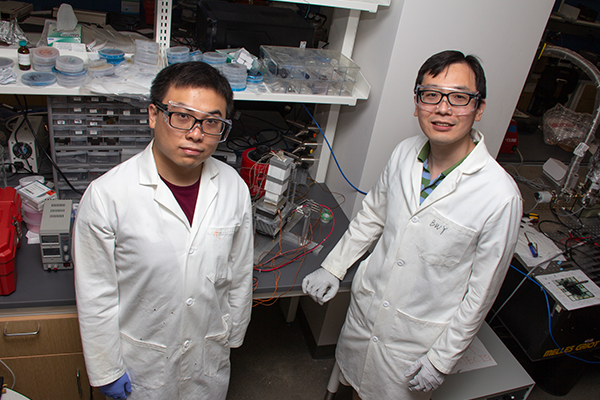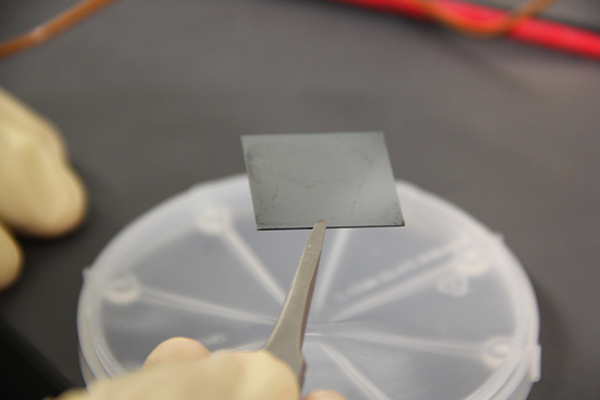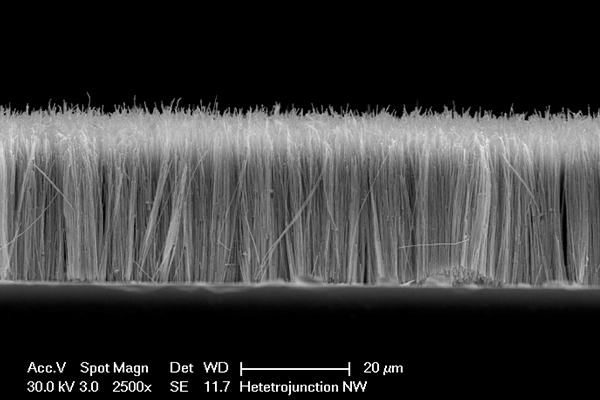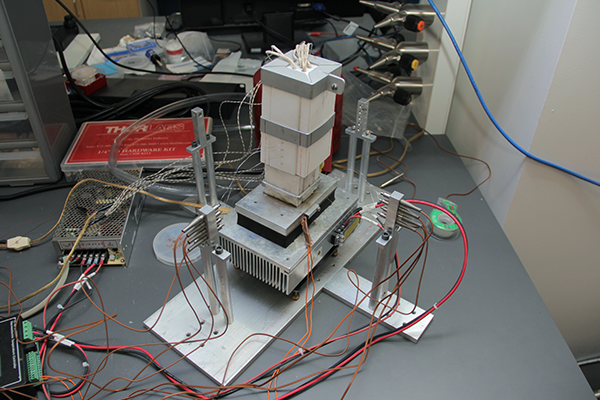Sheng Shen’s spectacular supersolder
Mechanical Engineering’s Sheng Shen has created “supersolder,” an ultracompliant thermal interface material with twice the thermal conductivity of conventional solders.
Sheng Shen has created a solder-like material called supersolder, with twice the conductivity of conventional solders and a compliance higher by two to three orders of magnitude.
In electronics, solder is used to connect two parts together. As a bridge, one of its most important functions is to transfer heat away from critical electronic components and toward the heat sink, which uses air or water to safely dissipate heat. As technological advances allow for the creation of smaller and more powerful computers and electronics—and with temperatures in computer chips reaching higher than 100 °C—this heat dissipation function has become more crucial than ever.
However, conventional solders are reaching the limit of their ability to conduct heat effectively over a long lifetime, making heat dissipation a limiting factor for further computing and electronics development. If these fields are to advance further, this crucial bottleneck will have to be overcome.
Enter “supersolder.”
The product of a 2013 DARPA Young Faculty Award, supersolder is a thermal interface material (TIM) developed by Shen, associate professor of mechanical engineering at Carnegie Mellon, in collaboration with researchers from the National Renewable Energy Laboratory. Four years of work have resulted in the creation of a material that can fill the same role as conventional solders, but with twice the thermal conductance of current state-of-the-art TIMs.
The secret behind Shen’s breakthrough is copper-tin nanowire arrays.
“The nanowires are grown from a template, like a mold, using small pores,” says Shen. “It’s chip technology using electroplating, grown one layer at a time, like how you coat an electrical cord by dipping it into electrolyte.”
The resulting array exhibits remarkable thermal properties, unparalleled by any current solder materials. However, it’s not just its thermal conductance that makes supersolder unique.
The only reason we ended the experiment was because we had to publish the paper!
Sheng Shen, Associate Professor, Mechanical Engineering, Carnegie Mellon University
Supersolder also exhibits extraordinary compliance, or elasticity, on par with that of rubber or other polymers. This is important, as the parts that the solder connects expand and contract when heated, often at varying rates between two parts of differing composition. Diminishing compliance is often the downfall of conventional solders, as they grow brittle over repeated use, degrading their ability to conduct heat over time. According to Shen, supersolder’s compliance is higher than these materials by two to three orders of magnitude.
An experiment his team conducted matched a supersolder assembly against a conventional solder assembly of tin. While the conventional solder began to decline in thermal conductance after less than 300 hours of cycling, the supersolder continued to operate at peak thermal conductance after more than 600 hours. In fact, it performed so well that its exact limits are still unknown.

Source: Carnegie Mellon University College of Engineering
Associate Professor Sheng Shen and his Ph.D. candidate Wei Gong
“We know it can keep going,” says Shen. “The only reason we ended the experiment was because we had to publish the paper!”
While the upper limits of supersolder’s capability are still being explored, it’s potential future applications are plain to see. Supersolder could replace conventional solder in electronic systems ranging from micro- and portable electronics to warehouse-sized data centers, reducing temperatures to enable significant improvements in power density and reliability. Anything conventional solder can do, supersolder can do better—almost.
While Shen is very pleased with the results from supersolder, his work is not yet complete; he still sees room for improvement. The material is electrically conductive: an attribute that is undesirable in certain applications. Therefore, his next goal is to create a version of supersolder that can retain its thermal conductance, while acting as an electrical insulator.
After four years of work, there is little that could deter him from perfecting his material.
“The idea is very simple: you have a challenge, and you keep trying until you make it work.”
Learn about Shen’s other work in polymer nanofibers and nanoenergy:



